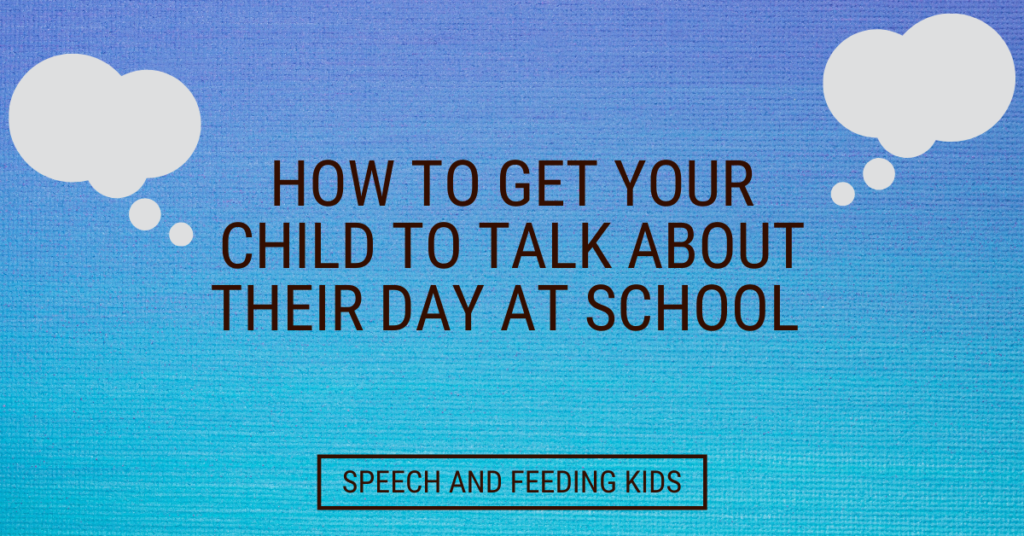The fastest way to get your child to say the word “good”…ask them “how was your day?”.
Some children come home and generally love talking about their day at school. Some love to be quizzed or be asked series of questions.
Other children may be more reluctant to tell you about their day because of negative feelings, or may genuinely struggle recalling events and answering questions. I have one of each in my house; a talker, and a “good” child. This post includes some strategies you can use to help facilitate a conversation about your child’s day at school.
How to approach asking questions:
If you’re working with a child who is less likely to tell you about their day:
1. Start with broad, factual questions
2. Gradually make the questions more complex (see types of questions below)
3. Give support and help expand/answer when possible
4. Use the information you gain, to help ask more specific questions
Types of questions:
You can start with yes/no factual questions and begin to build up from there. The following questions go from easy to more complex:
Vague yes/no: Yes/No questions are a great way to start. Especially if you know the answer to them already (i.e. you know your child had gym, or art that day, or that they played outside).
Examples: Did you have have recess outside today? Did you see Mikey today? Did you have a special today?
Basic “wh-question”: “Wh” questions will get you into the territory beyond yes/no. It may still only be one word answers; however, it’s more detailed information they have to recall and relate.
Who did you see at recess today? Where was gym today? What did you do at art today?
Specific “wh-question”: What did you and Mikey do at recess today?
Open ended question for interpretation: Can you tell me something funny about what you and Mikey did at gym today?
“Tell me what the hardest part of art was today?
Step 1 – Start Easy:
Start easy with (yes/no) and build from there. Take the information you gain and put it into the next question. Think of it as a flow chart that opens a door to the next question. One word answers are fine at first. We can use them to gain information to ask more questions, and to help the conversation be less effortful for the child. The last thing they want when they get home from school is another test.
Yes/no factual questions – “Did you have gym?” They either had gym, or did not have gym.
Yes/no preference question – “Did you have fun at gym? “This is a little more complex and requires them to recall both events and emotions. It could be yes, no, or both. Part of gym could have been fun, part of gym may not have. This will start to spark more memories about a specific event of their day.
Next step: Expand on Yes/No using “wh” questions
“Wh – questions” – Wh- questions are; who/what/when/where/why. All but “why”, are relatively straight forward and will be easier to answer. (Replace “gym” with any “special” or part of their day you know they did that day)
Who did you see at gym?
What did you play at gym today?
Who talked to you today?
What was the most fun part of gym?
Where did you have snack?
What did you eat for lunch?
When did you laugh today?
Step 2 – Stack the Information:
You can compound, or stack the information to make specific questions that may help the child answer more efficiently. Once you’ve gained some basic information, stacking that information into more specific questions is the best way to help them really share about their day. Imagine building a house. You need a foundation before you can do anything else.
Examples:
Did you have gym today?: Yes
Who did you see at gym today?: Morgan
What did you and Morgan do at gym today?: I played tag with Morgan
What was the most fun part of playing tag with Morgan at gym today?
Think about the difference between asking, “How was gym today?” vs. “What was the most fun part of playing tag with Morgan at gym today?”. Both are good questions; however, one is way more specific, and much more likely to give support and help elicit a longer response. When you begin to structure your questions with more detail and specificity, you will help your child by taking out some of the legwork in recalling the days events.
Here’s another example of stacking information to ask better questions:
Q: Did anything funny happen at school today? A: Yes
Q: Where did the funny thing happen? A: At recess
Q: Who did the funny thing happen with? A: With Mike
Q: Tell me about the funny thing that happened at recess with Mike today!
More examples of questions to ask:
Once you get into a rhythm try more open-ended questions and see how the child does. The following types of questions create more opportunities for longer responses:
Try replacing “how was your day at school?” with these:
Tell me something funny about your day.
Tell me something amazing that happened to you today.
Did you make anyone laugh today? Tell me about it.
Did anything incredible happen today? Tell me about it.
What was the most fun thing your learned today at school?
What was one of the harder parts of your day today at school?
Step 3 – Read Your Child:
This could arguably be the first step. Once you start getting the hang of asking your child questions in a more optimal way, you’ll begin to realize how to adjust accordingly. You’ll begin to realize the difference between the child really not wanting to talk at that moment, and really not being able to formulate response at that moment.
Understanding they may need some time right after school to unwind is also crucial. Try asking later in the evening. You can even give them the language to ask you. If this is the case, encourage them to ask you, “Can I tell you later?”
Understanding your child may genuinely have a harder time recalling and organizing responses is a different situation. Once you begin to realize the differences, you can respond accordingly and adapt. Understand that each day, you might have to press on, or back off, in different ways.
The biggest take-home is keeping in mind how you phrase questions. This will dictate how your child answers. The child may be giving you short answers, because you are asking short questions. If you’re asking yes/no questions, you are more likely to get a yes/no answer. If the goal is just getting your child to engage in a discussion about school, yes/no questions are a great place to start. But don’t stop at that level.
Final Thought:
Setting a precedent that after school, at some point, you are going to ask questions. You want to talk because you love them, and genuinely want to hear about their day. Don’t quit because you get multiple days with little to no responses. One thing you can try proactively telling them some of the questions you are going to ask after school, before they go to school. Make it silly like, “OK I’m really curious about what color shirt Mrs. B is wearing today. Can you take a look and tell me after school?” You’re can gamify it and start with something as simple as that.
Have lots of patience, and praise the child for any (even if small) amount of information they are able to share with you about their day!
Good Luck!
For more speech and language tips, follow Speech and Feeding Kids on YouTube.
About the Author
DRAKE HASTINGS M.S., CCC-SLP
Drake Hastings is a speech-language pathologist who specializes in speech, oral motor, and feeding therapy for kids. Drake has a passion for working with children and families while helping children achieve goals using a fun and motivating approach to learning.
Drake’s main areas of focus within the practice are feeding therapy, and speech (sound production) therapy. Drake has experience working with children who are diagnosed with Autism Spectrum Disorder, Apraxia of Speech, Dysarthria, Down Syndrome, and rare genetic disorders. Drake has experience working and collaborating with a wide variety of families and therapeutic team members while treating children of all ages.


